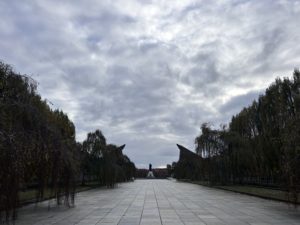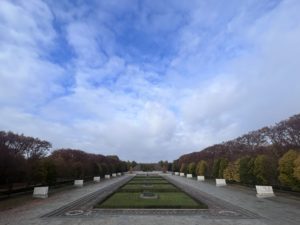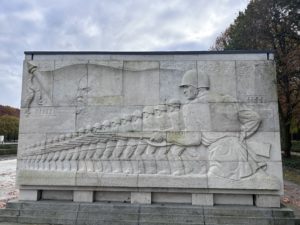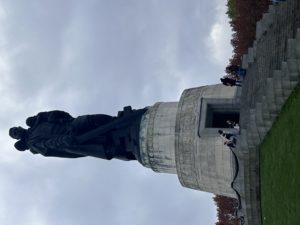Treptower Park Soviet War Memorial: A View of Berlin Through Red Tinted Glasses
By Suryansh Singh
Situated alongside the serpentine banks of the River Spree, Treptower Park Soviet War Memorial stands as an ornament placed within the region’s natural beauty, adding to the altar of the history of the city of Berlin. While many of the other remnants of the city’s Soviet past have been reclaimed through spray-paint graffiti and modern commercial buildings, this memorial, solemnly sitting away from the bustle of Berlin commemorates a blood soaked past from which the city was rebuilt. After the Battle of Berlin during World War II, the park was completed and opened to the public in 1949 as an effort to immortalize the 81,000 fallen on the side of the Red Army. While the memorial presents itself as an unquestionable, imposing marvel through its physical grandeur, it also hides a meticulously crafted narrative about East Berlin’s former liberators. After taking off the red-tinted glasses of Soviet storytelling, one can unearth a bigger, deeper picture of the memorial in the true colors of the Soviet Union, as displayed in the layout of its walkways, selective presentation of information, and cherry picked imagery.
The origins of Treptower Park Soviet War Memorial are rooted in the annals of a key battle to end World War II in Europe. The Battle of Berlin claimed not only over 81,000 Soviet military casualties, but also the lives of civilians in the tens of thousands. The timing of the construction of the park came immediately after the Second World War, as it was made between 1946 and 1949. This deliberate timing is crucial to understand the Soviet Union’s attempt to briskly establish its ideology for the citizens of East Berlin, and to reassert its contributions towards crushing fascism in Germany. Seeing the park as a tool for these geopolitical goals, upon entering, visitors come across arched gates with Soviet symbolism. Resembling the Arc de Triomphe in Paris, a great monument of a similar physical nature built to commemorate the deceased from the French Revolution, and the Napoleonic wars, a visual emulation of greatness and tribute from the Soviet Union is felt. Walking through the park’s singular entry path, visually guarded by well maintained trees, the eye of a viewer gravitates towards a statue of a woman. In a state of distress and pensiveness, holding her dress, she conveys the grief and mourning at the core of the park’s disclosed, intended purpose, the acknowledgement of death. Through numerous means such as this, the designers of the park establish the primary reason for its existence quite directly, mourning.
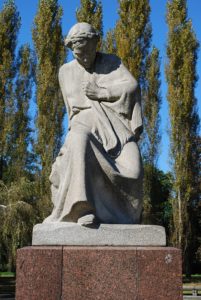
Soviet War Memorial (Treptower Park) Statue Mother Home big. Photo by Zeal is licensed under CC BY-SA 3.0.
Walking further into the park, through the only visible path shielded by Weeping Birch trees, another symbol of grief and loss, in the distance, an inviting and grand open field welcomes visitors maintaining the grim motif. As one walks down this path, they are greeted by two kneeling soldier statues at each side of a large, slanted, gate-like structure. Red in color, with clothlike creases, and a hammer and sickle on it, the imagery of a flag at half-mast concludes the last blatant symbol dedicated to mourning.[Insert photo: TreptowerPark_3 (Please tag image: Image by Suryansh Singh)] At the other end of this open space stands a statue different from the last few, displaying no grief, but instead a valiant, strong posture. Magnetically drawing park goers towards the statue, the
architects of the park display images of great bravery, fighting spirit, and wartime fraternity inscribed on sarcophagi modeled after those found in ancient Rome, symbolizing the dead, but this time, more subliminally. From French revolutionaries to the illustrious Romans, this likeness to past victors is interwoven subliminally within the construction of the park, making one question the larger intentions behind the symbolic messages of the park.
Apart from the sarcophagi, laurel wreaths and Corona Triumphalis crowns, Roman symbols of military, civic, or athletic excellence are imprinted on the pavements visible to park goers. While this symbolism acts as a reminder of how great the contributions of Soviet soldiers were to the liberation of Berlin, it also conveys a message about the type of nation the USSR seeks to project itself within East Berlin. The commissioners of the park sought to be likened with the Roman Empire, a civilization characterized by its prosperity, vast outspread, indomitable military might and cultural influence. As this subliminal messaging slowly seeps into the minds of citizens subconsciously, other direct displays of communist values, eminence, and superiority are mandated to be faced in order to take a walk around the park.
In the USSR’s ever aspired, controlled, indoctrinating manner, on one of the sarcophagi, the revolutionary mighty spirit of Lenin leads the Red Army into battle, and men and women participate hand in hand to defeat of Nazis. These rows of white sarcophagi tell a linear tale, one narrated by Stalin. On the side of each structure, quotes from Josef Stalin appear, recounting the great deeds of the USSR, as though it is Stalin himself walking visitors through the park. Intentionally, the participation of Soviet forces in World War II is also restricted to be between 1941 to 1945 on placards, ignoring Soviet perpetration of violence that entailed between 1939 and 1940, specifically with the invasion and capture of eastern Poland, which lead to the Polish people’s homeland being taken away from them, and the deaths of thousands of Poles. Through this creative choice, Soviet evils are conveniently forgotten to those who may see the park as an opportunity to learn, and consider it a credible access point towards the history of the war. A gargantuan statue of a Soviet soldier protecting a child, and confidently crushing a Nazi Swastika serves the motif of the USSR being the new caring, justice bringing, evil removing liberators of East Berlin, instead of instigators or perpetrators.
The park is also a proponent of other Soviet Values of inclusion, equality, and the elimination of class based struggle. At the mausoleum, a mosaic of individuals from all walks of life, and all ends of the USSR commemorate the fallen in unity. At this moment, the USSR reminds park goers that women, children, people in fine suits or farm clothing, and even those in traditional Central Asian, not particularly European clothing are united as one in the USSR. For the cause of the Soviet Union, everybody is alike and everybody is together. Economic access to the park is also a testament to this. While today, only a few runners and families enjoyed the park’s space, in the time of East Berlin where access and assembly were limited, this park would have acted as a robust center for gathering, regardless of financial status and class, for free. Whether through obvious means, or
hidden ones, the constructors of the park seek to instill these values, images, and narratives into the minds of the citizens of East Berlin.
Treptower Park Soviet War Memorial remains as a physical reminder of Soviet sacrifice and victory. It also embodies a sense of justice brought against the Nazi perpetrators on behalf of the people of Berlin and Germany. However, within this tapestry of history, the USSR weaves threads of its ideology, greatness, and intent to portray itself as one of the greatest civilizations there ever was. Whether to indoctrinate future generations, or assimilate what were East Berliners into its promised communist utopia, the Soviet constructors of the park leave no loose ends, using symbolism, deliberate selection of facts, architecture, and imagery to assert their desired narrative.
References
- Swift, John. “Battle of Berlin”. Encyclopedia Britannica, 10 Oct. 2023, https://www.britannica.com/topic/Battle-of-Berlin. Accessed 28 November 2023.
- Hickman, Kennedy. “World War II: Battle of Berlin.” ThoughtCo, Apr. 5, 2023, thoughtco.com/world-war-ii-battle-of-berlin-2361466.

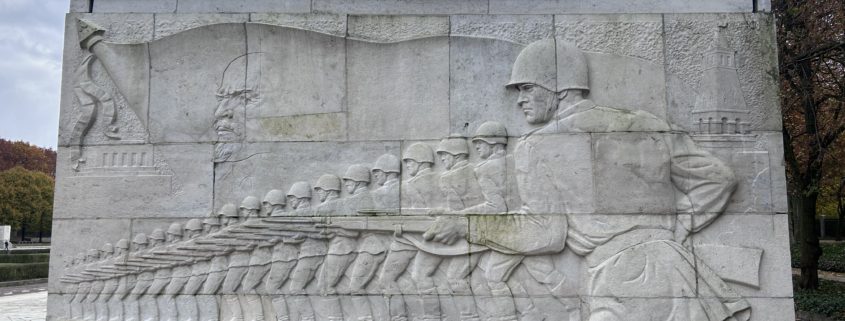
![Entrance to Soviet War Memorial. Photo by Dr. Avishai Teicher is licensed under CC BY-SA 4.0)].](https://urbanlabsce.eu/wp-content/uploads/2023/12/TreptowerPark_1-300x225.jpeg)
